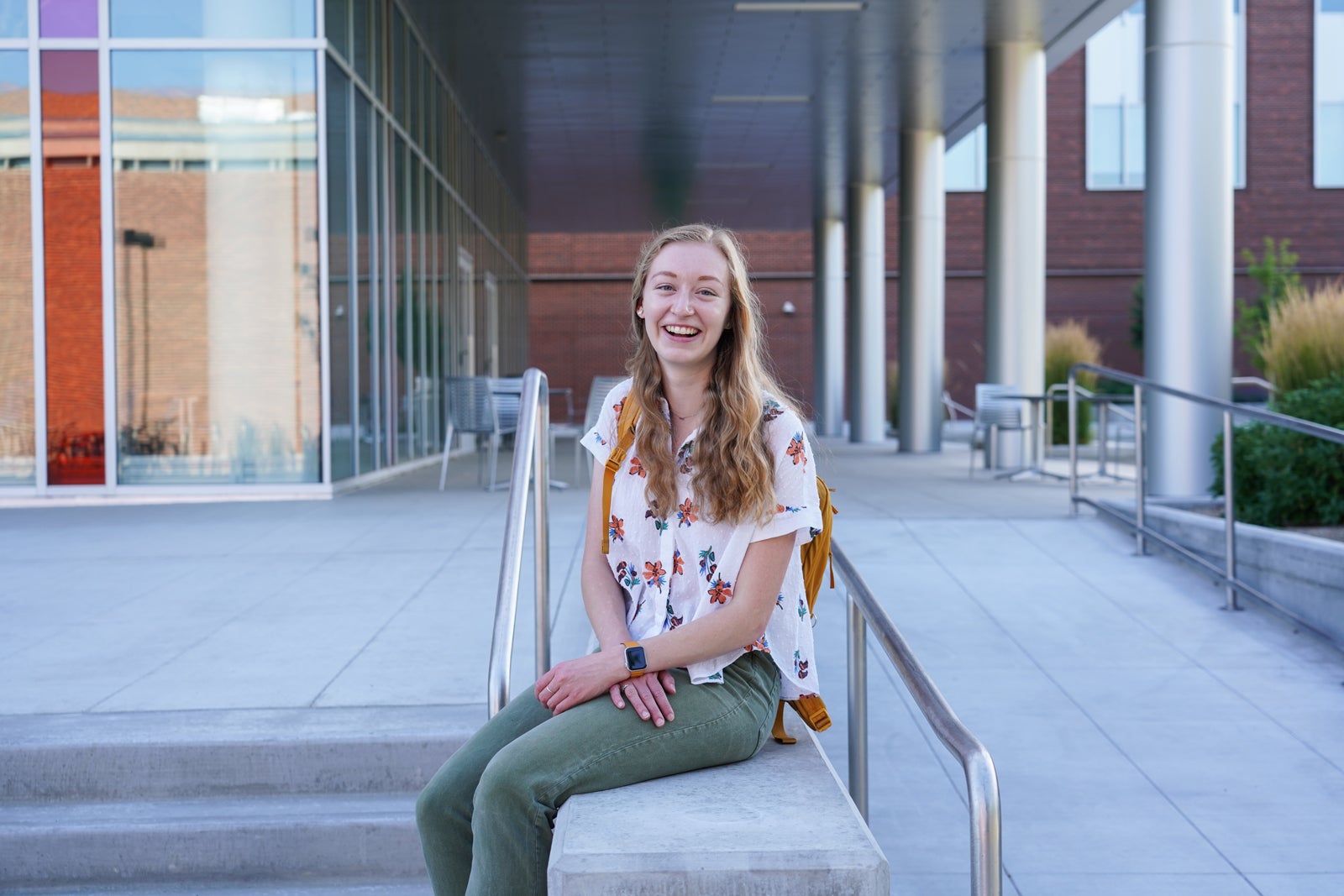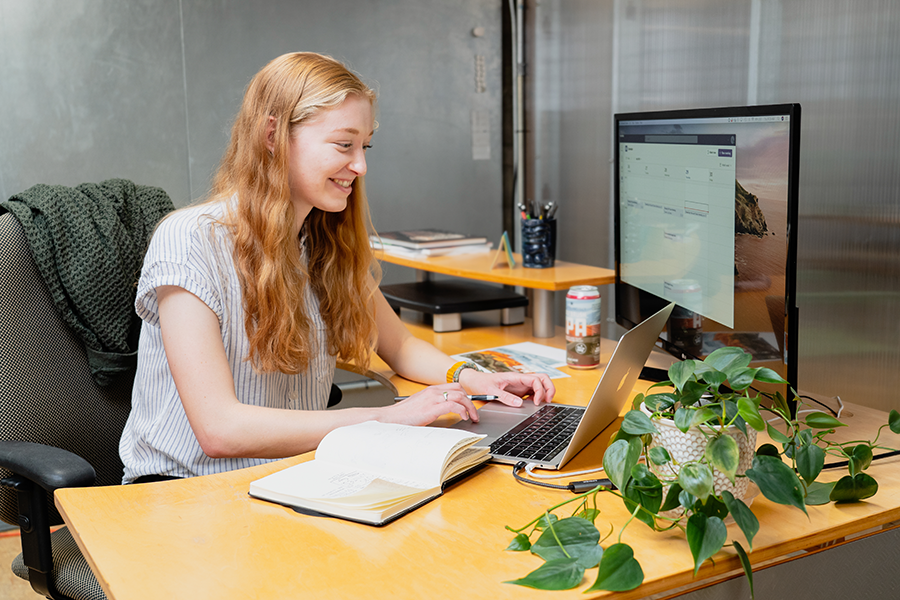Like many 18-year-old high school graduates, Clara Adams struggled to know how to pursue her passions in college and plan for a future career.
“I have always been an artist at heart. It is what I love to do, and it is my passion, but I didn’t know what to do with it coming out of high school,” Adams explained. “It’s sometimes hard to know what creativity or art will look like in a career setting.” College seemed like a natural next step to help Adams refine her creative skills and explore career options.
Step One: Choose Boise State University + Blue Turf Thinking
“I knew college would help me figure out what exactly I wanted to do and how I could pursue that passion in a way that would drive me forward, better myself and help others.” So Adams, a Portland, Oregon native, started to tour colleges.
“Finding Boise State was one of those experiences where I stepped on campus, and I was like, ‘I could picture myself here,’” she said. “I took a tour and fell in love!”
Boise State University attracts talented students like Adams with Blue Turf Thinking — a mindset that results in unique academic programs that transcend disciplines, experiential learning opportunities and spaces and programs specifically devoted to innovation.
Now, as a senior with a certificate in user experience design and internship experience, Adams has shaped a unique path to a creative career as a designer and artist.

Step Two: Learn Job-Ready Skills to Prepare For Your Future
Clara Adams discovered the College of Innovation + Design at Boise State last year. She started exploring their many certificate programs aimed at job or career readiness to add to her graphic design bachelor’s degree. She eventually chose the User Experience Design Certificate, knowing that user experience design is in the country’s top ten most sought-after job skills (Indeed.com).
“The series of user experience courses transformed how I design, how I look at design in the world, how I think about communicating and how I approach solving a problem,” Adams said.
The User Experience Design Certificate offered through the College of Innovation + Design establishes a foundation in design thinking and human-technology interaction. It also provides opportunities to earn more user experience credentials during the course of study.
User Experience Design is one of many certificate options that you can stack together to form a bachelor’s degree through Boise State’s newest online program, Digital Innovation + Design. Choose certificates to create the degree that aligns with your interests and goals. Individual certificates indicate your mastery of a variety of skills and give you immediately applicable knowledge. This degree program merges technology and creativity, equipping you with new ways of thinking and doing so you can solve real-world problems and foster innovation.
Step Three: Seek Learning Opportunities that Merge Technology + Creativity
Clara Adams enjoyed the diversity of thought and experiences of her fellow user experience design peers.
“I enjoyed a lot of UX classes. I’d say that they were some of the most engaging online courses that I’ve taken because they involve students coming from all different fields,” she explained. “There were a lot of creatives wanting to learn how to communicate better through technology and computer science majors and tech students looking to be more creative. I was able to see how people with different backgrounds tend to approach and solve problems. In coming together, we can solve problems and design solutions more effectively.”
The User Experience Design Certificate and the Digital Innovation + Design degree unite technology, creativity and design, so you are prepared with diverse skills and knowledge to tackle complex problems in your future workplace.
Step Four: Get Meaningful Work Experience
Adams knew that she also needed work experience. “I had to start getting connected into the professional world. I started applying to internships. It was honestly very challenging,” Adams said. “I knew about Oliver Russell, so I reached out via email to Russell Stoddard, the company’s founder. He hopped on a Zoom call with me, and we started talking.”
“I do have to say that with most interviews I went through this spring, having user experience design on my resume was great. It was one of the first things they asked about. It led to some great conversations,” she said.
Adams started working as a summer intern for Oliver Russell, a Certified B Corporation with a mission to “partner with other like-minded business founders and executive teams to elevate the stories of brands with the potential to make our world a better place.”
“User experience design has helped me tremendously in how I approach projects at Oliver Russell,” she said. “We are developing e-courses to help educate clients on specific topics. In designing these courses, the visuals are all about communications. Thinking about what we are communicating and who we are speaking to are questions I asked myself and know how to answer because of the User Experience Design Certificate.”
“I also love working for a place that has so much purpose. I feel really, really good about what I am doing. It is amazing to be a part of an agency that is striving to do so much good.”

Step Five: Create and Design for Good
So, what does Clara Adams have planned for the future?
“I want to do something with purpose in the future. My work experience has helped me shape what I am looking for a little bit more,” Adams explained. “I know I can make the world a better place with good design. As long as I’m doing that, I’ll be ok.”
The new Bachelor of Arts in Digital Innovation + Design offers courses like Designing for Equity to help students like Adams, who are interested in learning how to design for all. The course builds competencies in listening to identities at the margins and centering those experiences to design for equity and accessibility. Stacy Parsons, co-founder and partner of The Dignitas Agency, serves as the instructor and brings 20 years of experience in developing inclusive and equitable practices and goals in organizations. Designing for Equity is one innovative class offered by the digital innovation + design program. There are many more where industry leaders serve as teachers to the next generation of creators and designers.
Explore More Digital Innovation + Design Classes
Digital Innovation + Design: Now Accepting Applications for Spring 2022
Want to learn more about the Bachelor of Arts in Digital Innovation + Design? Have a question? Not sure where to start?
The Boise State Digital Innovation + Design program team is here for you! Student success coaches guide you through the admissions process, advisors help you overcome challenges as you navigate your degree plan, faculty employ real-world design experience and staff remove barriers to solve problems. We are ready to help and eager to support you!
